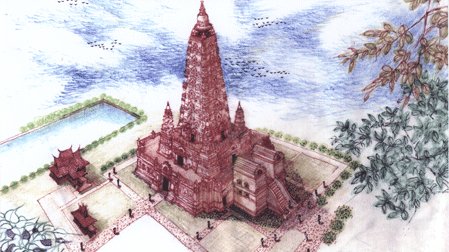A Pagoda Grows in Thailand

In the winter of 2000 Bhikkhu Sopako Bodhi (then Achan Sobin Namto) traveled to Bodhgaya, India, the site where the Buddha gained enlightenment. There, near the famous Mahabodhi Temple, he ordained for a second time into the sangha, the community of Buddhist monks.
The Mahabodhi temple houses one of the world's most impressive Buddha statues, the Buddha Metta or Buddha of Loving-Kindness. Bhikkhu Sopako decided to commission a statue in the image of the Buddha Metta and also build a large pagoda in which to house it.
 (A pagoda is a multi-storied memorial tower.) Like the
Buddha statue, the pagoda would be a replica of the one at
the Mahabodhi Temple. These would be erected at the
monastery in his hometown of Wangplado, Thailand.
(A pagoda is a multi-storied memorial tower.) Like the
Buddha statue, the pagoda would be a replica of the one at
the Mahabodhi Temple. These would be erected at the
monastery in his hometown of Wangplado, Thailand.
In early 2004, a meditation hall on the grounds of Bhikkhu Sopako's monastery burned to the ground. The Buddha statue inside was irreparably damaged. He and the other monks commissioned workers to rebuild the hall. At the same time, artisans began to construct the Buddha Metta statue from the highest quality Burmese white jade, to replace the one damaged in the fire. This new statue, completed in 2004, is nearly five feet across at the base, and well over five feet high. The funding for the Buddha Metta statue and part of the meditation hall was raised by a group of Ven. Sopako's students from Denver, Colorado.
After completing the Buddha statue and rebuilding the meditation hall, Ven. Sopako began planning for the larger pagoda project, which will eventually include an international meditation center. This plan required finding an architect willing to travel to India to make sketches from the original building.
Some signs of transformation are already evident in Wangplado. Preparation has begun to lay the foundation for the pagoda. The new meditation hall glints red and gold in the sun. And visitors can see the individual meditation huts (kutis) dotted around the pond. In this tranquil, natural setting, students from all over the world can practice meditation in the same type of hut used by Thai monks.
Establishing the pagoda and meditation center in Wangplado will allow Bhikkhu Sopako to spread the teaching of vipassana to greater numbers of people in his last years. Although he has dedicated his life to helping others be free of suffering, although he's spent forty-five years teaching vipassana in temples and centers around the world, Ven. Sopako has never had a center that he could call his own. It is his sincere hope that by establishing a meditation center in Wangplado his teachings will survive him and continue to benefit beings everywhere. This dhamma is too precious to lose.
But Bhikkhu Sopako needs your help if the project is to succeed. As he is now in his seventies and in poor health, he relies on a staff of assistants. Moreover, the current funding for the project is not adequate. Any help that you might offer, whether a donation of time, services, or money, would be tremendously appreciated. Would you like to help?
Your donation of time or money to the Vipassana Dhura Meditation Society, a 501C3 nonprofit corporation, will not only help Bhikkhu Sopako complete this great work, but will bring merit and benefit to your own life. It doesn't matter what amount you donate; even five or ten dollars will help.
However, Ven. Sopako realizes that not everyone is able to make a monetary donation. He wants his students and friends to know that the support of the mind is the most important support you can provide. Whether you donate money or not, he asks that you keep his project in your minds and hearts. If we all take the time to visualize its completion, the power of our combined thoughts will be of great benefit.